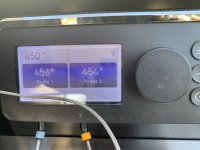RogerPrice
New member
Hello. I’ve been playing around with balancing out the heat in my ex 6 by using removable heat deflectors on the right side. I have it pretty dialed in now. In the process one of my meat probes that I was using to monitor one side of the cooker just blanked out. I noticed it was really far off from the other probe to begin with so maybe defective and possibly the reason I though my grill was 100° Hotter on the right side. More tests to follow.
Question 1. Are meat and ambient probes different. Maybe high ambient temps are hard on the meat probes but I’ve never had a problem with other meat probes in the past
Question 2. What’s the max limit on the meat probes? I was shooting for 450 when it blanked out.
Question 1. Are meat and ambient probes different. Maybe high ambient temps are hard on the meat probes but I’ve never had a problem with other meat probes in the past
Question 2. What’s the max limit on the meat probes? I was shooting for 450 when it blanked out.


